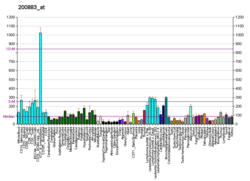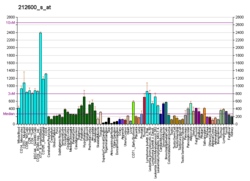UQCRC2
Cytochrome b-c1 complex subunit 2, mitochondrial is a protein that in humans is encoded by the UQCRC2 gene.[5][6][7]
Its gene product is a subunit of the respiratory chain protein Ubiquinol Cytochrome c Reductase (UQCR, Complex III or Cytochrome bc1 complex), which consists of the products of one mitochondrially encoded gene, MTCYTB (mitochondrial cytochrome b) and ten nuclear genes: UQCRC1, UQCRC2, Cytochrome c1, UQCRFS1 (Rieske protein), UQCRB, "11kDa protein", UQCRH (cyt c1 Hinge protein), Rieske Protein presequence, "cyt. c1 associated protein", and "Rieske-associated protein".
References
- 1 2 3 ENSG00000140740 GRCh38: Ensembl release 89: ENSG00000284493, ENSG00000140740 - Ensembl, May 2017
- 1 2 3 GRCm38: Ensembl release 89: ENSMUSG00000030884 - Ensembl, May 2017
- ↑ "Human PubMed Reference:".
- ↑ "Mouse PubMed Reference:".
- ↑ Duncan AM, Ozawa T, Suzuki H, Rozen R (Feb 1994). "Assignment of the gene for the core protein II (UQCRC2) subunit of the mitochondrial cytochrome bc1 complex to human chromosome 16p12". Genomics. 18 (2): 455–6. PMID 8288258. doi:10.1006/geno.1993.1500.
- ↑ Hosokawa Y, Suzuki H, Toda H, Nishikimi M, Ozawa T (Sep 1989). "Complementary DNA encoding core protein II of human mitochondrial cytochrome bc1 complex. Substantial diversity in deduced primary structure from its yeast counterpart". J Biol Chem. 264 (23): 13483–8. PMID 2547763.
- ↑ "Entrez Gene: UQCRC2 ubiquinol-cytochrome c reductase core protein II".
Further reading
- Hosokawa Y, Suzuki H, Toda H, et al. (1990). "The primary structure of the precursor to core protein II, a putative member of mitochondrial processing protease family, of rat mitochondrial cytochrome bc1 complex deduced from cDNA sequence analysis.". Biochem. Int. 20 (4): 731–7. PMID 2162168.
- Hu WH, Hausmann ON, Yan MS, et al. (2002). "Identification and characterization of a novel Nogo-interacting mitochondrial protein (NIMP).". J. Neurochem. 81 (1): 36–45. PMID 12067236. doi:10.1046/j.1471-4159.2002.00788.x.
- Strausberg RL, Feingold EA, Grouse LH, et al. (2003). "Generation and initial analysis of more than 15,000 full-length human and mouse cDNA sequences.". Proc. Natl. Acad. Sci. U.S.A. 99 (26): 16899–903. PMC 139241
 . PMID 12477932. doi:10.1073/pnas.242603899.
. PMID 12477932. doi:10.1073/pnas.242603899. - Ota T, Suzuki Y, Nishikawa T, et al. (2004). "Complete sequencing and characterization of 21,243 full-length human cDNAs.". Nat. Genet. 36 (1): 40–5. PMID 14702039. doi:10.1038/ng1285.
- Gerhard DS, Wagner L, Feingold EA, et al. (2004). "The status, quality, and expansion of the NIH full-length cDNA project: the Mammalian Gene Collection (MGC).". Genome Res. 14 (10B): 2121–7. PMC 528928
 . PMID 15489334. doi:10.1101/gr.2596504.
. PMID 15489334. doi:10.1101/gr.2596504. - Wen JJ, Garg N (2005). "Oxidative modification of mitochondrial respiratory complexes in response to the stress of Trypanosoma cruzi infection.". Free Radic. Biol. Med. 37 (12): 2072–81. PMID 15544925. doi:10.1016/j.freeradbiomed.2004.09.011.
- Rual JF, Venkatesan K, Hao T, et al. (2005). "Towards a proteome-scale map of the human protein-protein interaction network.". Nature. 437 (7062): 1173–8. PMID 16189514. doi:10.1038/nature04209.
- Ewing RM, Chu P, Elisma F, et al. (2007). "Large-scale mapping of human protein-protein interactions by mass spectrometry.". Mol. Syst. Biol. 3 (1): 89. PMC 1847948
 . PMID 17353931. doi:10.1038/msb4100134.
. PMID 17353931. doi:10.1038/msb4100134.
This article is issued from
Wikipedia.
The text is licensed under Creative Commons - Attribution - Sharealike.
Additional terms may apply for the media files.





